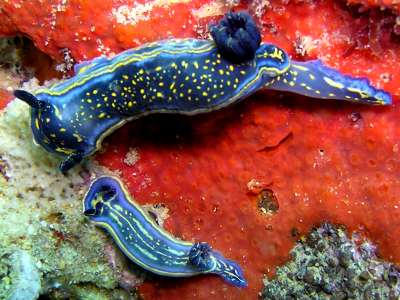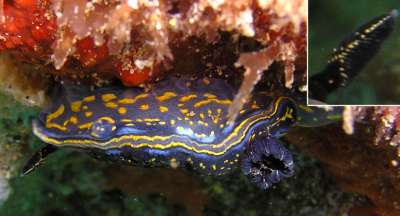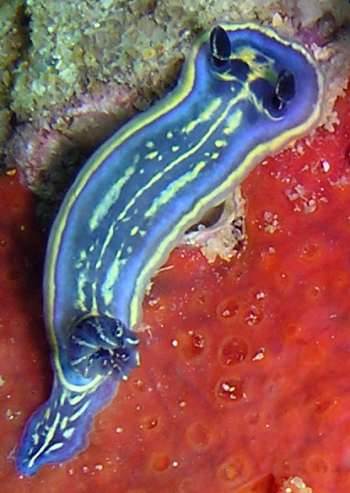Hypselodoris malacitana or H. cantabrica?
September 13, 2005
From: David Abecasis


Dear Bill,
Concerning your comments to my last message [#14719], I have more photos, from some other animals but I'm not sure if they are the same species. These were also taken in Algarve (South Portugal).
Locality: Faro, Algarve, Portugal. Depth: 12 metres. 29 June 2005. Photographer: David Abecasis
Best regards,
David Abecasis
davidbecas@netcabo.pt
Abecasis, D.A., 2005 (Sep 13) Hypselodoris malacitana or H. cantabrica?. [Message in] Sea Slug Forum. Australian Museum, Sydney. Available from http://www.seaslugforum.net/find/14740
Dear David,
Thanks for the extra photos. I have had another look at the revision by Ortea, Valdes & Garcia-Gomez (1996) on these blue chromodorids and find it all a bit puzzling. What I did note is that they consider H. malacitana is only known from the Mediterranean coast of southern Spain while H. cantabrica is found on the Atlantic coast. if that is a real distribution, then your animal should be H. cantabrica. There are very few distinguishing features I can see from their account. The only direct comparison I can find in their work of the two species is that H. cantabrica had unicuspid jaw rodlets and H. malacitana has bicuspid rodlets, however these can differ in different parts of the jaw plates and in fact in Fig 82 it looks as though both types are present in the jaw plate of the H. malacitana specimen they illustrate. As I mentioned in your last message [#14719], they describe the rhinophore of H. malacitana having an inverted yellow Y down the posterior midline. I also note that they consider a T shaped yellow mark between the rhinophores to be important in H. cantabrica. In the photo alongside, your animal has the T shape of one species and the inverted Y shape of the other!
It gets even more complicated when they say elsewhere in the revision that H. bilineata has these same inverted Y rhinophore markings, and that juvenile H. malacitana can have a double white line down the dorsal midline, which is the distinguishing feature of H. bilineata. It seem to me we need to know more about about populations of these animals and their biology. It is certainly complicated by the fact that at least some of these species appear to be mimicking each other, but at present it seems we still have to determine just how many species there actually are.
On reflection, I think we should identify your animals as Hypselodoris cantabrica. I would very much like some comments from local experts.
Best wishes,
Bill Rudman
Related messages
-
Hypselodoris cantabrica and parasite
From: Joao Pedro Silva, September 8, 2007 -
Hypselodoris cantabrica laying eggs.
From: Joao Pedro Silva, June 17, 2006 -
Hypselodoris cantabrica? from Portugal
From: David Abecasis, September 13, 2005 -
Hypselodoris cantabrica feeding
From: Marina Poddubetskaia, December 24, 2004 -
Hypselodoris cantabrica egg-ribbons
From: Marina Poddubetskaia, December 24, 2004 -
Photo of Hypselodoris cantabrica
From: Erwin Koehler, March 19, 2000
